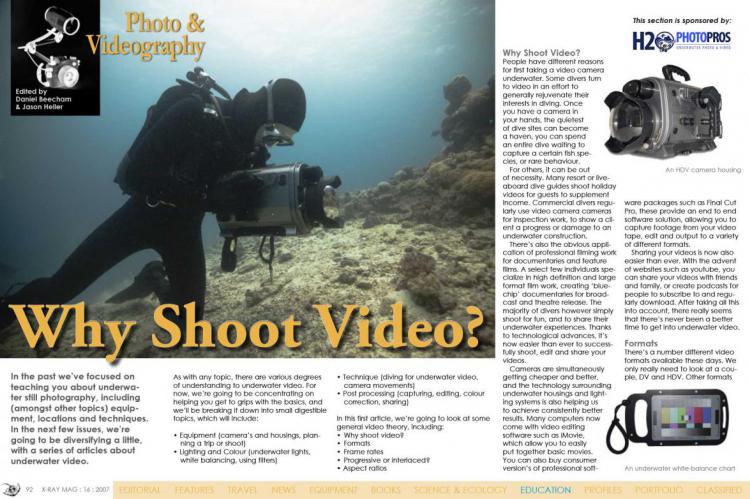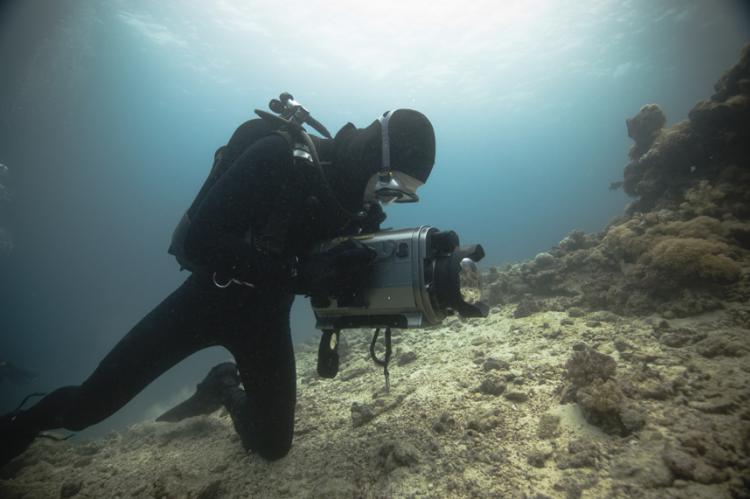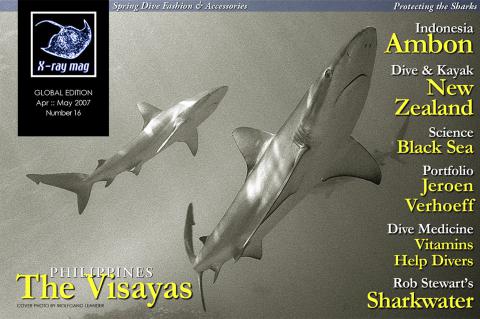Why shoot video?
In the past we’ve focused on teaching you about underwater still photography, including (amongst other topics) equipment, locations and techniques. In the next few issues, we’re going to be diversifying a little, with a series of articles about underwater video.
Tags & Taxonomy
As with any topic, there are various degrees of understanding to underwater video. For now, we’re going to be concentrating on helping you get to grips with the basics, and we’ll be breaking it down into small digestible topics, which will include:
• Equipment (camera’s and housings, planning a trip or shoot)
• Lighting and Colour (underwater lights, white balancing, using filters)
• Technique (diving for underwater video, camera movements)
• Post processing (capturing, editing, colour correction, sharing)
In this first article, we’re going to look at some general video theory, including:
• Why shoot video?
• Formats
• Frame rates
• Progressive or interlaced?
• Aspect ratios
Why Shoot Video?
People have different reasons for first taking a video camera underwater. Some divers turn to video in an effort to generally rejuvenate their interests in diving. Once you have a camera in your hands, the quietest of dive sites can become a haven, you can spend an entire dive waiting to capture a certain fish species, or rare behaviour.
For others, it can be out of necessity. Many resort or live-aboard dive guides shoot holiday videos for guests to supplement income. Commercial divers regularly use video camera cameras for inspection work, to show a client a progress or damage to an underwater construction.
There’s also the obvious application of professional filming work for documentaries and feature films. A select few individuals specialize in high definition and large format film work, creating ‘blue-chip’ documentaries for broadcast and theatre release. The majority of divers however simply shoot for fun, and to share their underwater experiences. Thanks to technological advances, it’s now easier than ever to successfully shoot, edit and share your videos.
Cameras are simultaneously getting cheaper and better, and the technology surrounding underwater housings and lighting systems is also helping us to achieve consistently better results. Many computers now come with video editing software such as iMovie, which allow you to easily put together basic movies. You can also buy consumer version’s of professional software packages such as Final Cut Pro, these provide an end to end software solution, allowing you to capture footage from your video tape, edit and output to a variety of different formats.
Sharing your videos is now also easier than ever. With the advent of websites such as youtube, you can share your videos with friends and family, or create podcasts for people to subscribe to and regularly download. After taking all this into account, there really seems that there’s never been a better time to get into underwater video.
Formats
There’s a number different video formats available these days. We only really need to look at a couple, DV and HDV. Other formats generally remain solely the territory of professional cinematographers, and are not suitable for recreational divers for a number of reasons, including the costs involved, as well as the logistical issues relating to transportation of large numbers of support equipment that professional systems demand.
DV has been a popular format for a long time now, and is still very popular today. The cameras are still available to buy, as are the housings and other support equipment, but the advent of a newer, better format has taken DV’s place as the most common video format in use.
Roughly three years ago, Sony released their first HDV camera. Since this time, the HDV format—which was created by a consortium of manufacturers including Sony, Canon, Sharp and JVC—has gained tremendous popularity. Many production companies and networks have adopted the format for a variety of uses. Often times, to save costs, a production may consist of a mixture of true
High Def material alongside HDV material, the picture quality is that good. Even though its been adopted by major industry players, don’t think that HDV is for professionals only. Many different manufacturers produce HDV cameras, and there are models available for as little as $1000, which produce stunning results. More and more cameras become available, some of which even have switchable frame rates, or can be switched between progressive or interlaced modes. Both DV and HDV use the same storage medium—mini-DV videocassette tapes.
FPS, Frames per Second
The number of images that a video camera records in a second is known as the ‘frame rate’. In order to trick the eye into seeing movement rather than a series of still images, a minimum number of frames per second must be seen. Old mechanical cameras used to shoot frame rates as slow as six or eight fps, but modern, professional level cameras can shoot as much as 120fps, which can be used to show fast action in slow motion.
Different geographical regions use different frame rates, for example Europe, Asia and Australasia use 25fps, which is known as PAL. USA, Canada and Japan, etc., use NTSC or 29.97fps. Generally, you’ll only ever shoot the frame rate that is used in your country of residence. (...)
Download the full article ⬇︎

Originally published
X-Ray Mag #16
PHILIPPINES - Diving the Visayas. AMBON - the spice islands in Indonesia. Protecting the Sharks: Wolfgang Leander + Rob Stewart/Sharkwater movie. Divemedicine: Why antioxidants protects divers. NEW Zealand - land of the Kiwis. Rebreathers: Comfort and Efficiency. WHY shoot video. SPRING DIVE Fashion. Science: The Black Sea. New Equipment. Report from Moscow.



